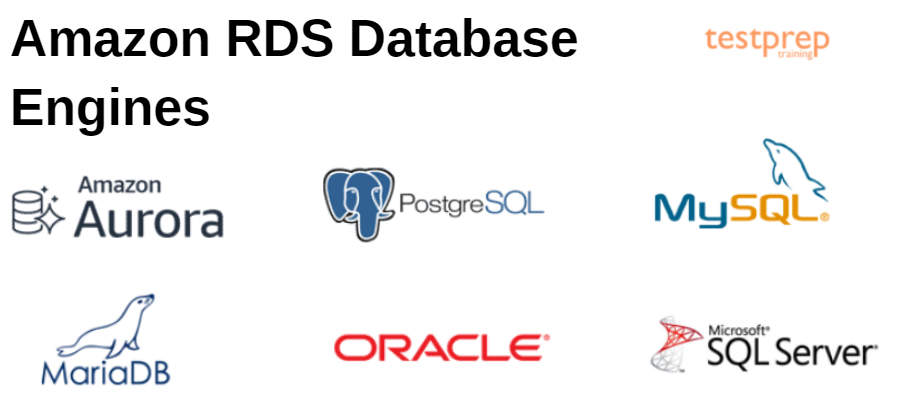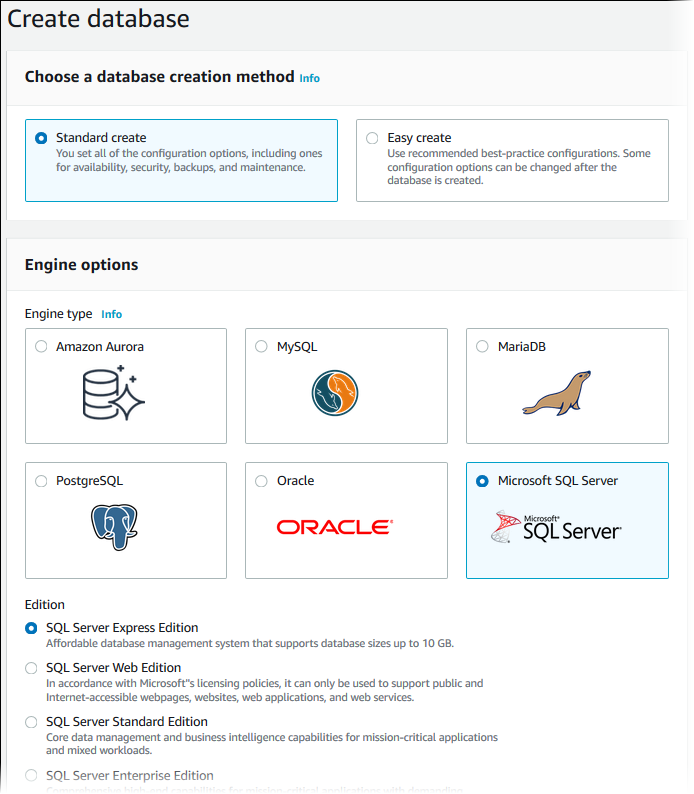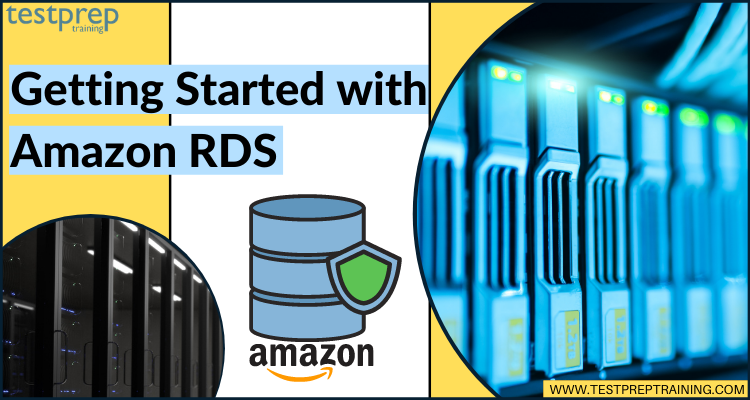Management of data over the cloud has become a source for increasing the organization’s growth and performance. But, on the other side, it has also created confusion about the cloud-like whether it will provide benefits by using database services or not. Starting with a cloud service requires full-proof planning and strategy. However, to resolve these issues, Amazon has provided a solution for handling the database by getting started with Amazon RDS.
Here, in this blog, we will understand what exactly Amazon RDS is and how it is benefiting the top companies with its unique features. So, let’s get started with it.
What is Amazon RDS?
Amazon RDS is a Relational Database Service used for operating, and scaling a relational database in the cloud. Moreover, it is considered yo be cost-efficient and provides resizable capacity during automating time-consuming administration tasks. Amazon RDS helps you to focus on your applications to get fast performance, high availability, security, and compatibility.

Moving on, below we will be talking about the uniques features of Amazon RDS that make it best in terms of database.
What are the Amazon RDS Features?
Amazon RDS is a fully managed relational database service that comes with database engines. It operates routine database tasks like provisioning, patching, backup, recovery, failure detection, and repair. Moreover, it makes it easy to use replication for enhancing availability and reliability for production workloads. To understand more accurately, check the features mentioned.
1. Lower administrative burden
Easy to use
- In this, you can use the AWS Management Console and the Amazon RDS Command Line Interface for accessing the capabilities of a production-ready relational database in minutes.
Automatic software patching
- Amazon RDS ensures that the relational database software powering your deployment stays up-to-date with the latest patches.
Best practice
- Amazon RDS provides best practice by analyzing configuration and usage metrics from your database instances.
2. Performance
General Purpose (SSD) Storage
- Amazon RDS General Purpose Storage is an SSD-backed storage option for delivering a consistent baseline of 3 IOPS per provisioned GB. Moreover, it provides the ability to burst up to 3,000 IOPS above the baseline.
Provisioned IOPS (SSD) Storage
- Amazon RDS Provisioned IOPS Storage refers to an SSD-backed storage option for delivering fast, predictable, and consistent I/O performance. When creating a database instance, you specify an IOPS rate.
3. Availability and durability
Automated backups
- Amazon RDS has an automated backup feature for enabling point-in-time recovery for your database instance. Moreover, it will backup your database and transaction logs and store both for a user-specified retention period.
Database snapshots
- Database snapshots are user-initiated backups of your instance that are stored in Amazon S3. Moreover, you can create a new instance from database snapshots whenever you desire.
Multi-AZ deployments
- For database instances, Amazon RDS Multi-AZ deployments provide high availability and durability. This makes them a natural fit for production database workloads. However, when you provision a Multi-AZ database instance, then, Amazon RDS synchronously replicates your data for a standby instance for a different Availability Zone (AZ).
4. Security
Encryption at rest and in transit
- Amazon RDS allows the encryption of databases using keys you manage using AWS Key Management Service (KMS). However, data stored at rest in the underlying storage is encrypted on a database running with Amazon RDS encryption. This also includes automated backups, read replicas, and snapshots.
- Further, Amazon RDS has the support of Transparent Data Encryption in SQL Server and Oracle. In which, Transparent Data Encryption in Oracle is integrated with AWS CloudHSM for securely generating, storing, and managing your cryptographic keys in a single-tenant Hardware Security Module.
Network isolation
- AWS recommends running your database instances in Amazon VPC. This will help in isolating your database in your own virtual network and connecting to your on-premises IT infrastructure using encrypted IPsec VPNs.
Resource-level permissions
- Amazon RDS is integrated with AWS Identity and Access Management (IAM). This has the ability to control the actions that your AWS IAM users and groups can take on specific Amazon RDS resources.
5. Manageability
Monitoring and metrics
- Amazon RDS provides Amazon CloudWatch metrics for your database instances at no additional charge. Moreover, you can use the RDS Management Console for viewing key operational metrics, including compute/memory/storage capacity utilization, I/O activity, and instance connections.
Event notifications
- Amazon RDS can notify you via email or text message of database events using Amazon SNS. Moreover, you can use the AWS Management Console or the Amazon RDS APIs for subscribing to over 40 different database events associated with your database instances.
Configuration governance
- Amazon RDS integrates with AWS Config for supporting compliance and enhance security by recording and auditing changes to the configuration of your DB instance including parameter groups, subnet groups, snapshots, security groups, and event subscriptions.
6. Cost-effectiveness
Pay only for what you use
- There is no up-front commitment with Amazon RDS; you simply pay a monthly charge for each database instance that you launch. And, you can delete it after finishing with a database instance.
Reserved instances
- Amazon RDS Reserved Instances give you the option for reserving a DB instance for a one or three-year term and in turn receive a significant discount compared to the On-Demand Instance pricing for the DB instance.
Stop and start
- Amazon RDS allows you to easily stop and start your database instances for up to 7 days at a time. This makes it easy and affordable to use databases for development and test purposes.
Now, in the upcoming section we will understand why most companies are migrating to Amazon RDS using it database engines.
Amazon RDS Database Engines

1. Amazon Aurora
- Amazon Aurora is a MySQL and PostgreSQL-compatible relational database for the cloud. It mixes the performance and availability of traditional enterprise databases with the simplicity and cost-effectiveness of open source databases.
- Secondly, Amazon Aurora is faster than standard MySQL databases and PostgreSQL databases.
- Thirdly, it provides the security, availability, and reliability of commercial databases at 1/10th the cost.
- Lastly, Amazon Aurora is fully managed by Amazon Relational Database Service (RDS). That is to say, it automates time-consuming administration tasks like hardware provisioning, database setup, and patching.
Benefits:
- Firstly, it provides high performance and scalability.
- Secondly, Amazon Aurora offers high availability and durability.
- Thirdly, for database Amazon Aurora provides multiple levels of security.
- Next, it has compatibility with existing MySQL and PostgreSQL open source databases.
- Amazon Relational Database Service (RDS) manages Amazon Aurora.
- Lastly, it provides migration Support. Moreover, MySQL and PostgreSQL compatibility make Amazon Aurora a compelling target for database migration to the cloud.
2. Amazon RDS for PostgreSQL
- PostgreSQL has become the most used open-source relational database for many enterprise developers and start-ups for leading business and mobile applications.
- Secondly, it makes it easy for setting up, operating, and scaling PostgreSQL deployments in the cloud.
- Thirdly, with Amazon RDS, you can deploy scalable PostgreSQL deployments in minutes with cost-efficient and resizable hardware capacity. Lastly, it gives you access to the capabilities of the familiar PostgreSQL database engine in which you can use the code, applications, and tools you already use.
Benefits:
- Firstly, PostgreSQL provides managed deployments.
- Secondly, for the PostgreSQL database, Amazon RDS provides two SSD-backed storage options.
- Thirdly, Amazon RDS has an automated backup feature that enables recovery of your PostgreSQL database instance to any point in time within your specified retention period of up to thirty-five days.
- Next, Amazon RDS Multi-AZ deployments provide enhanced availability and durability for your PostgreSQL databases.
- Lastly, Amazon RDS for PostgreSQL provides Amazon CloudWatch metrics for your database instances at no additional charge and Amazon RDS Enhanced Monitoring provides access to over 50 CPU, memory, file system, and disk I/O metrics.
3. Amazon RDS for MySQL
- MySQL is a popular open-source relational database. Using Amazon RDS for MySQL makes it easy for setting up, operate, and scale MySQL deployments in the cloud. You can deploy scalable MySQL servers in minutes using Amazon RDS features.
- Secondly, Amazon RDS for MySQL frees you up to focus on application development by managing time-consuming database administration tasks including backups, software patching, monitoring, scaling, and replication.
- Lastly, Amazon RDS supports MySQL Community Edition versions 5.6, 5.7, and 8.0. This means that the code, applications, and tools you use today can be used with Amazon RDS.
Benefits:
- Firstly, MySQL provides managed deployments.
- Secondly, for the MySQL database, Amazon RDS provides two SSD-backed storage options.
- Thirdly, Amazon RDS has an automated backup feature that enables recovery of your MySQL database instance to any point in time within your specified retention period of up to thirty-five days.
- Next, Amazon RDS Multi-AZ deployments provide enhanced availability and durability for your MySQL databases.
- Lastly, Amazon RDS for MySQL provides Amazon CloudWatch metrics for your database instances at no additional charge and Amazon RDS Enhanced Monitoring provides access to over 50 CPU, memory, file system, and disk I/O metrics.
4. Amazon RDS for MariaDB
- MariaDB refers to a popular open-source relational database developed by the original developers of MySQL. However, Amazon RDS makes it easy for setting up, operating, and scaling MariaDB server deployments in the cloud. You can deploy scalable MariaDB cloud databases fastly using Amazon RDS and its features.
- Secondly, Amazon RDS lets you focus on your application by managing time-consuming database administration tasks. This includes backups, software patching, monitoring, scaling, and replication.
- Lastly, Amazon RDS supports MariaDB Server versions 10.2, 10.3, 10.4, and 10.5. This means with Amazon RDS you can use the code, applications, and tools you already use today.
Benefits:
- Firstly, Amazon RDS for MariaDB makes it easy to manage the database by automating complex tasks involved in setting up and maintaining the database.
- Secondly, it makes it easy to use replication for enhancing availability and reliability for production workloads.
- Next, by using Amazon RDS for MariaDB, you pay only for the resources you provision.
- In this, you can scale your Amazon RDS for MariaDB instances up to 32 vCPUs and 244GiB Memory.
- Lastly, Amazon RDS makes implementing database security easier for the MariaDB database. That is to say, it isolates your data within an Amazon VPC and can automatically encrypt your data in transit.
5. Amazon RDS for Oracle
- Amazon RDS for Oracle refers to a fully managed commercial database that makes it easy for setting up, operating, and scaling Oracle deployments in the cloud.
- Secondly, Amazon RDS frees you up to focus on innovation and application development by managing time-consuming database administration tasks including provisioning, backups, software patching, monitoring, and hardware scaling.
- Thirdly, you can run Amazon RDS for Oracle under two different licensing models – “License Included” and “Bring-Your-Own-License (BYOL)”.
- Next, in this, you can take advantage of hourly pricing with no upfront fees or long-term commitments.
Benefits:
- Firstly, Amazon RDS for Oracle is handled by Amazon Relational Database Service (RDS).
- Secondly, Amazon RDS for Oracle makes it easy to use replication for enhancing availability and reliability for production workloads.
- Thirdly, Amazon RDS for Oracle offers managed service solution benefits. You can use the lift-and-shift approach for migrating your legacy Oracle database to Amazon RDS for Oracle.
- Next, Amazon RDS General Purpose (SSD) storage delivers a consistent baseline of 3 IOPS per provisioned GB. Moreover, it provides the ability for bursting up to 3,000 IOPS.
- Lastly, it provides a Multi-AZ deployment option in which you can run mission-critical workloads with high availability and built-in automated fail-over from your primary database to a synchronously replicated secondary database in case of a failure.
6. Amazon RDS for SQL Server
- SQL Server is a relational database management system developed by Microsoft. Amazon RDS for SQL Server makes it easy for operating and scaling SQL Server deployments in the cloud.
- Secondly, with Amazon RDS, you can deploy multiple editions of SQL Server including Express, Web, Standard, and Enterprise.
- Thirdly, Amazon RDS for SQL Server supports the “License Included” licensing model.
- Next, you can take advantage of hourly pricing with no upfront fees or long-term commitments. In addition, you also have the option for purchasing Reserved DB Instances under one or three-year reservation terms.
- Lastly, Amazon RDS for SQL Server DB Instances can be provisioned with either standard storage or Provisioned IOPS storage. Amazon RDS Provisioned IOPS is a storage option designed to deliver fast, predictable, and consistent I/O performance, and is optimized for I/O-intensive, transactional (OLTP) database workloads.
Benefits:
- Firstly, Amazon RDS for SQL Server is fully managed by Amazon Relational Database Service (RDS).
- Secondly, with a single click, you can enable the Multi-AZ option, replicating data synchronously across different availability zones.
- Thirdly, by opting into Auto-Scale storage, instances will automatically increase the storage size with zero downtime. With RDS Storage Auto Scaling, you only have to set your desired maximum storage limit. And, Auto Scaling takes care of the rest.
- Next, Amazon RDS creates and saves automated backups of your SQL Server instance. Amazon RDS creates a storage volume snapshot of your instance by backing up the entire instance.
- Amazon RDS SQL Server offers Enterprise, Standard Edition, Web, and Express Editions for SQL Server Versions 2012, 2014, 2016, and 2017.
- Lastly, we support a number of ways to migrate to Amazon RDS SQL Server, including Single and Multi-file native restores, Microsoft SQL Server Database Publishing Wizard, Import/Export, AWS Database Migration Service, and SQL Server Replication.
Above we have understood about the database engines that makes Amazon RDS powerful in the database sector. Now, we will learn to create DB instance to get more clarity about Amazon RDS.
Creating an Amazon RDS DB instance
- Firstly, sign in to the AWS Management Console. Then, open the Amazon RDS console at https://console.aws.amazon.com/rds/.
- Secondly, choose the AWS Region in which you want to create the DB instance in the Amazon RDS console.
- Thirdly, in the navigation pane, choose Databases.
- Now, select Create database.
- After that, select Standard Create in the database creation method.
- Next, choose the engine type in Engine options. This can be MariaDB, Microsoft SQL Server, MySQL, Oracle, or PostgreSQL.

- However, if you’re using Oracle or SQL Server for the edition, then, choose the DB engine edition that you want to use.
- MySQL has only one option for the edition, and MariaDB and PostgreSQL have none.
- And, for Version, choose the engine version.
- Further, in Templates, choose the template that matches your use case. If you choose Production, then, follow the preselected in a later step:
- Multi-AZ failover option
- Provisioned IOPS storage option
- Enable deletion protection option
- Now, to enter your master password, do the following:
- Firstly, in the Settings section, open Credential Settings.
- Then, clear the Auto-generate a password check box.
However, the new DB instance uses an automatically-generated password by default for the master user.
- After that, for the leftover sections, specify your DB instance settings.
- Then, select Create database.
- However, the View credential details button appears on the Databases page only if you chose to use an automatically generated password.
- Further, choose View credential details for viewing the master user name and password for the DB instance.
- Then, for connecting to the DB instance as the master user, use the user name and password that appear.
- Lastly, choose the name of the new DB instance for Databases.
- Then, on the RDS console, the details for the new DB instance appear. There the DB instance has a status of creating until the DB instance is created and ready for use. When the state changes to available, then, you can connect to the DB instance.
Check out the use cases below to enhance your level of interests in Amazon RDS with learning about the top companies using this database service.
Use cases: Amazon RDS
1. Web and mobile applications
Web and mobile applications developed for operating at a very large scale need a database with high throughput, massive storage scalability, and high availability. Amazon RDS fulfills the needs of such highly demanding applications with room for future growth.
Example include:
 Airbnb
Airbnb
Airbnb chose Amazon RDS for simplifying the time-consuming administrative tasks associated with databases. Moreover, it uses Multi-Availability Zone (Multi-AZ) deployment for automating its database replication and augment data durability.
2. Ecommerce applications
Amazon RDS offers small and large e-commerce businesses a flexible, secured, highly scalable, and low-cost database solution for online sales and retailing. Moreover, Amazon RDS provides a managed database for meeting PCI compliance and focuses on building high-quality customer experiences without worrying about the database.
Example Include:
 Instacart
Instacart
For avoiding the complexities of building a new production database from scratch, Instacart migrated to Amazon RDS for their new same-day grocery delivery service. The company now has the power to add millions of new items to its database every month. Moreover, its engineering team can focus on developing new features and improving the overall customer experience.
3. Mobile and online games
Mobile and Online games need a database platform with high throughput and availability. Thus, Amazon RDS manages the database infrastructure so game developers have no need to worry about provisioning, scaling, or monitoring database servers. In this, Amazon RDS provides familiar database engines for growing capacity to meet user demand.
Example Include:
 Bandai Namco
Bandai Namco
Bandai Namco Studios uses Amazon RDS for providing better performance, lower costs, better security, and greater availability for their arcade, social and mobile games.
Final Words
Above we have learned and understood the various services and features related to Amazon RDS. This database service provides techniques for setting up, operating and scaling data using just a few clicks. By using the database engines of RDS, many big companies have migrated to these services. So, start exploring Amazon RDS services using the resources and get yourself advanced in it!



